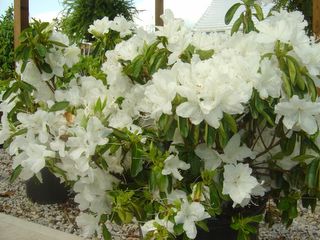THE OLD SIGN PHILOSOPHER, THOUGHT FOR THE DAY!
MULCH MADNESS SALE.....NOW RED MULCH
SORRY NOT NCAA APPROVED
XXXXXXXXXXXXXXXXXXXXXXXXXXXXXXXXXXXXXXXXXXXXXX
ANOTHER LOAD OF OREGON GROWN STOCKAnother load of awesome stock arrived this morning from Oregon. 62 more LARGE Japanesse Maples, 150 arborvitaes, 20 variegated dogwoods (incredible plants).......the list goes on and on. Check out these plants for your next landscape project.
xxxxxxxxxxxxxxxxxxxxxxxxxxxxxxxxxxxxxxxxxxxxxxxxxxxxxxxxxxxxxxxxxxxxxxx
PERENNIAL PLANT OF THE YEAR PROGRAM TURNS 15
Started in 1990 by Perennial Plant Association, the Perennial Plant of the Year program's initial intent was to promote perennials to the general public. PPA exec. dir. Steve Still said it was basically the 1st plant of the year program of its type. Still said the 2,000 PPA members choose a plant based on several factors, including: suitability within a wide range of climates; low maintenance; easy propagation; and ability to attract interest throughout the year. The goal is to select a species that gardeners in the U.S. and Canada can grow and maintain. This year’s plant is Helleborus x hybridus, Lenten rose. Dianthus gratianopolitanus 'Feuerhexe' (Firewitch) has been selected for 2006.
xxxxxxxxxxxxxxxxxxxxxxxxxxxxxxxxxxxxxxxxxxxxxxxxxxxxxxxxxxxxxxxxxxxxx
GARDENIA........"HEAVEN'S SCENT"
Gardenias have a well-earned reputation for being difficult specimens for even the experienced indoor gardener. Gardenias thrive on bright light, high humidity, and an even supply of moisture and nutrients. When gardenias are freshly delivered from a greenhouse grower, their glossy leaves and heavenly-scented blooms just about cause the plant to leap into your arms, whether a gift for yourself or for a loved-one.
But, then, the plant enters the home environment where hot, dry air and gloomy winter days send the gardenia in a downward spiral. Those delicate flower buds, so filled with promise of good things to come, begin dropping from the plant in droves. The glossy leaves turn dull, yellow, and they, too, begin to drop like tree leaves in autumn. If the plant survives this cruel change in environment, mealy bugs, spider mites, scale insects and stem cankers provide further challenges to overcome.
Now for the good news. Gardenias can be successfully grown in the home, but they won’t tolerate neglect like many other houseplants. Gardenias are native to China and Japan but also grow well as an evergreen shrub in the south and west coastal areas of the United States. There, the plant reaches up to 6 feet tall! Gardenias thrive in bright light, cool temperatures and moderately humid air.
Your challenge in growing the gardenia as a houseplant is to match the plant’s native environment as closely as possible. First, make sure you give the plant plenty of bright light, preferably direct sunshine for at least half a day. Winter will likely be the most difficult time to keep high light intensity due to shorter, gloomy days. Moving plants closer to southern-exposure windows and/or supplementing with plant-grow lights will help. Cooler room temperatures are best for the gardenia, around 55 F at night and about 10 degrees warmer by day.
Maintaining proper relative humidity is a challenge, particularly during the winter heating season. There are several ways to help increase humidity, including running a humidifier and grouping plants together on trays of wet pebbles. Misting by hand with a spray bottle offers only momentary relief and so does not really increase humidity in a meaningful way.
A healthy, blooming gardenia will need to be nurtured with a steady supply of water and nutrients, but don’t overdo. The goal is to provide the proper balance of water, air and nutrients. If soil is kept constantly wet, the roots will be starved for air. Too much fertilizer can lead to damaging salt accumulation. Monitor the soil frequently for moisture content, and water thoroughly as the top inch of soil dries. Use a fertilizer that is formulated for acid-loving, blooming plants, such as an azalea-type product, according to rates listed on the label.
Don’t be afraid to prune the gardenia; in fact, blooming will be more prolific on younger growth. Remember that the gardenia is a woody shrub in its native environment and so may need to have older, woody stems removed to encourage new branches.
Though the responsibilities of gardenia care are daunting, if you persevere, you’ll be rewarded with elegant white blossoms and sweet fragrance that simply cannot be matched by other plants.
XXXXXXXXXXXXXXXXXXXXXXXXXXXXXXXXXXXXXXXXXXXXXXXXXXXXXXXXXXX
PURPLE CONEFLOWER THIS WEEK'S PERENNIAL SPOTLIGHT
The purple coneflower cultivar 'Magnus' is the perennial plant of the week. Known botanically as Echinacea purpurea 'Magnus,' this cultivar and species was selected for its outstanding performance as a sun-loving, long-flowering perennial that is easy to grow.
Purple coneflower is native to the midwestern plains, though the cultivar 'Magnus' hails from a Swedish nursery and is named for the plant's breeder. Purple coneflower as a species is noted for its upright, 4-foot tall plants with flower heads made up of a central cone of bronze-colored "disc" flowers surrounded by highly-colored, downward curving "ray" flowers ranging from white to purple to red.
'Magnus' is noted for its crimson-red bold flowers with a wide, flat petal display, lending the flower head a larger appearance. Like its parent species, 'Magnus' is well adapted to a wide range of growing conditions, including somewhat droughty sites. However, optimum flowering results from being planted in well-drained loamy soil to which some organic matter, such as compost, peat moss or dried manure has been added. The plants may be slow to get started in cool spring conditions, but will catch up rapidly once hot summer weather takes over.
xxxxxxxxxxxxxxxxxxxxxxxxxxxxxxxxxxxxxxxxxxxxxxxxxxxxxxxxxxxxxxxxxxx
LIFE IS A BEER
There seems to be a website for just about everything in the world today. To further the knowledge of the greenblog we bring you a
website that you just can't life without.
